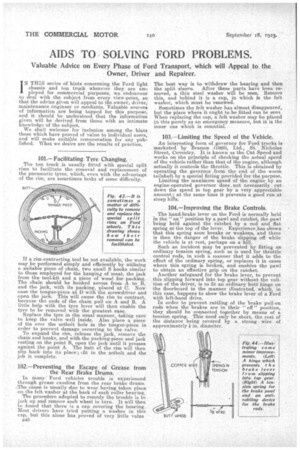AIDS TO SOLVING FORD PROBLEMS.
Page 22

If you've noticed an error in this article please click here to report it so we can fix it.
Valuable Advice on Every Phase of Ford Transport, which will Appeal to, the Owner, Driver and Repairer.
IN THIS series of hints concerning the Ford light chassis and ton truck wherever they are em-. played for commercial purposes, we endeavour to deal with the subject from every view-point, so that the advice given will appeal to the owner, driver; maintenance engineer or mechanic. Valuable sources of information are being tapped for this purpose, and it should be understood that the information given will be derived from those with an intimate knowledge of the subject.
We shall welcome for inclusion among the -hints those which have proved of value to individual users, and will make suitable remuneration for any published. What we desire are the results of practice.
101.— Facilitating Tyre Changing.
The ton truck is usually fitted with special split rims to facilitate the removal and replacement of the pneumatic tyres, which, even with the advantage of the rim, are sometimes tasks of some difficulty.
If a rim-contracting tool be not available, the work may be performed simply and efficiently by utilizing a suitable piece of chain, two small S hooks similar to those employed for the hanging of meat, the jack from the tool-kit and a piece of wood for packing. The chain should be hooked across from A to B, and the jack, with its packing, placed at C. Now ease the tongue-piece at D with the screwdriver and open the jack. This will cause the rim to contract, because the ends of the chain pull on A and B. A little help with the tyre lever will then enable the tyre to be removed with the greatest ease. Replace the tyre in the usual manner, taking care to keep the valve well inside. Also place a piece of tin over the setbolt hole in the tongue-piece in order to prevent damage occurring to the valve. To expand the rim, release the jack, remove the chain and hooks, and with the packing-piece and jack resting on the point B, open the jack until it presses against the point A. The butt of the rim will then slip back into its place ; fit in the setbolt and the job is complete.
102.—Preventing the Escape of Grease from the Rear Brake Drums. •
In Many' Ford vehicles trouble is experienced through grease exuding from the rear brake drums. The cause is usually due to wear having taken place on the felt washer at the back of each roller bearing. The procedure adopted to remedy the trouble is to jack up and remove each wheel in turn. It will theu be 'found that there is a cap covering the bearing. Most drivers have tried putting a washer in this cap, but this alone ha.s proved of very little value B40 The best way is to withdraw the bearing and then the split sleeve. After these parts have been removed, a thin steel washer will be seen. Remove this, and behind it is a cup, in which is the felt washer, which must be renewed. Sometimes the felt washer has almost disappeared, but the place where it ought to be fitted can be seen. When replacing the cap, a felt washer may be placed in this purely as an emergency measure, but it is the inner one which is essential.
103.--Limiting the Speed of the Vehicle.
An interesting form of governor for Ford trucks is marketed by Brame° .(1920), Ltd., St. Nicholas Street, Coventry: It is known as the Cut Speed and works on the principle of checking the actual speed of the vehicle rather than that of the engine, although actually it controls the throttle. This is obtained by operating the governor from the end of the worm tailshaft by a special fitting provided for the purpose.
Limiting the maximum speed of the engine by an engine-operated governor does, not necessarily cut down the speed in top gear by a very appreciable, amount' at the same time it prevents a good run at steep hills.
104.—Improving the Brake Controls.
The hand-brake lever on the Ford is normally held in the " on " position by a pawl and ratchet, the pawl being held against the ratchet by a rod and flat spring at the top of the lever. Experience,has shown that this •spring soon breaks or weakens, and there is then the danger of the brake slipping off while the vehicle is at rest, perhaps on a' hill. Such an incident may be prevented by fitting an ordinary tension spring, such as is used for throttle control rods, in such a manner that it adds to the effect of the ordinary spring, or replaces it in cases where this spring is broken, and enables the pawl to obtain an effective grip on the ratchet.
Another safeguard for the brake lever, to prevent this slipping forward into top gear without the volition of the driver, is to fit an ordinary butt hinge on the floorboard in the manner illustrated, -which, in this case, happens to show the brake lever of a Ford with left-hand. drive.
In order to prevent rattling of the brake pull-on rods when the brakes are in their " off " position, they should be connected together by means of a tension spring. This need only be short, the rest of the distance being covered by a strong wire of approximately in. diameter.




























